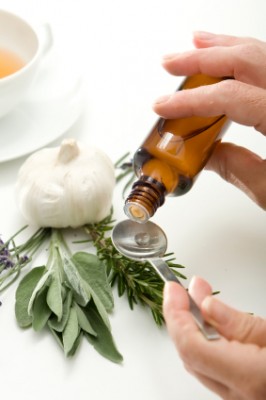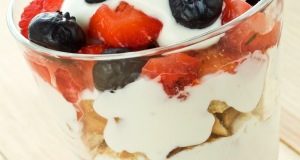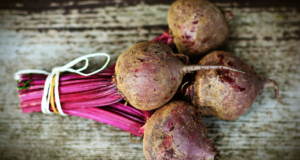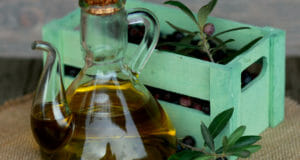 If you’ve ventured into a natural food store or an herbalist’s shop, you’ve no doubt encountered tinctures. Hundreds of tiny amber bottles line the shelves of the herbalists’ shop, filled with herbal tinctures for almost any ailment. But what exactly is a tincture, and how is it made?
If you’ve ventured into a natural food store or an herbalist’s shop, you’ve no doubt encountered tinctures. Hundreds of tiny amber bottles line the shelves of the herbalists’ shop, filled with herbal tinctures for almost any ailment. But what exactly is a tincture, and how is it made?
Tinctures are fascinating—part science, part ancient magic—and they’re very effective at relieving acute symptoms as well as chronic conditions. They seem mysterious, but they’re actually among the simplest herbal concoctions you can make. If you’ve ever made homemade vanilla by soaking vanilla beans in vodka, then you know the basics of making tinctures. Tinctures are simply the result of macerating herbs in liquid for several weeks.
The Benefits of Tinctures
Unlike fresh or dried herbs, which lose their potency quickly, tinctures remain stable and effective for months and sometimes even years. They don’t require a teapot or other equipment to prepare, and they come in small bottles, making them ideal for travel or the family medicine cabinet.
Best of all, tinctures are concentrated forms of herbs and act quickly in the bloodstream. You only need a few drops to bring relief—an important consideration when you’ve got an agitated, ill child who won’t drink an entire cup of tea. Tinctures can relieve stress, headaches, cold symptoms, and even acute pain in a matter of minutes.
Getting Started
To start with, you need to decide on a liquid to macerate the herbs in. This liquid, known as a menstruum, will draw the vitamins, nutrients and volatile oils out of the herbs and also act as a preservative.
Alcohol is probably the most popular menstruum and is an ideal choice for tinctures for creating acute conditions, such as pain or illness. Highly effective at extracting all the plant’s compounds, it’s also the best preservative. Alcohol tinctures move into the blood stream at lightning speed as well. Choose an alcohol that is between 80 and 100 proof, such as gin, vodka or brandy, and buy the best quality alcohol you can afford. Don’t use wine for making tinctures because the alcohol content is too low.
Old-time herbalists often use apple cider vinegar as a menstruum. It’s inexpensive, nontoxic, and suitable for children and adults. Tinctures made with apple cider are less potent than those made with alcohol, but vinegar has some health benefits that alcohol lacks. Use vinegar as a menstruum for tonic tinctures—meaning those you take every day to treat a chronic condition or to maintain overall health.
Finally, glycerin makes a good menstruum for children because it tastes sweet and is nutritious. It isn’t quite as effective as alcohol at extracting volatile oils from herbs, but it makes an acceptable substitute in most cases. Combine two parts glycerin with one part water to make a menstruum. Buy pure, food-grade vegetable glycerin at natural food stores; do not use glycerin made from animal fat, which is used for cosmetic purposes rather than consumption.
Making Tinctures
Newer herb manuals often have complicated recipes for tinctures that call for exact measuring and mixing. You’re better off taking a cue from old timers though, who knew how to keep things simple. Don’t worry too much about whether you’re doing it right or not. Tincture-making is a lot like cooking. The best way to learn is simply to get in the kitchen and start doing. As you practice, you’ll gain valuable experience and learn which tinctures work best for you and your family.
To make tinctures the old-fashioned way, simply mince fresh herbs on a cutting board. You can use dried herbs too, but fresh herbs are more potent and flavorful. Pour the fresh herbs in a pint glass jar and cover them with your chosen menstruum. Add two to three additional inches of liquid. Cover the jar and store it in a cool, dark, dry location for six weeks. Shake it occasionally and cover it with more liquid if the herbs become exposed.
After six weeks, the tincture is finished. Strain the tincture through a collander lined with cheesecloth into a clean pint jar. Label the tincture with a note that details the date you made it, the exact ingredients, dosage directions, and what it’s used for. Specifically, be sure to note whether it’s meant for internal or external use.
Using Tinctures
Most tincture bottles have confusing dosage instructions that go something like “Put ten to sixty drops under the tongue.” With such a wide range of acceptable doses, how do you know which one to use? Here’s a hint: use smaller doses for children and for minor illness. Use larger doses for adults and acute illness. Always start with the smallest dose and work up. In general, it’s safe to take one-fourth to half of a teaspoon two or three times daily for chronic issues. For acute illness, take one-eighth to one-fourth of a teaspoon every hour or two.
Putting the drops directly under your tongue is the simplest, most straightforward way to take them, but you can also put them in water, juice, or tea. Tinctures have a potent, sometimes bitter, flavor, so add some honey if you like.
Storing Tinctures
Don’t make more than one pint of tincture at a time. Store the tincture in sealed glass jars in a dark location, or in amber jars if you can get them. Many people prefer to transfer some of the tincture into small amber jars for convenience. You’ll find these bottles at natural food stores or online sources.
Final Notes
When you first start making tinctures, it’s usually best to use single herb compounds. Later, when you understand the properties of each herb, you can combine herbs to make a more potent tincture.
Herbs contain powerful medicinal compounds, and it’s important to use them safely. Learn about herbs from a certified herbalist and consult your health provider before mixing tinctures and medications.
Which herbs should you use for tinctures? Start with some commonly used ones. Echinacea and goldenseal, for example, are commonly used to treat infections, colds, and flu. Valerian, skullcap, and motherwort are used to relieve pain, stress and anxiety, or to combat insomnia.
Take some classes or get a good herbal guide, such as Brigitte Mars’ The Desktop Guide to Herbal Medicine. Always make sure you understand the contraindications of any herb before using it, and again, check with a physician or healthcare provider before starting any sort of treatment.
©2012 Off the Grid News
 Off The Grid News Better Ideas For Off The Grid Living
Off The Grid News Better Ideas For Off The Grid Living



